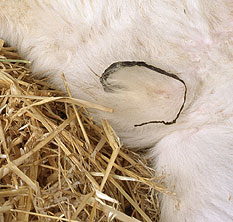A calf must be born in a clean calving area. If it isn’t, it is at a higher risk for a navel infection, also called joint ill.

The navel is the gateway to the liver. Bacteria enter a calf’s circulatory system by way of the navel into the liver, and then into the bloodstream. Navels should be dry, thin and not swollen.
The navel should be palpated every day for two weeks to check for swelling or pain, which would indicate there may be a sign of a navel infection. There should be no drainage or foul smell, nor should palpation cause a painful response from the calf.
Preventing navel infections in newborn calves
A navel cord is a highway into a calf’s bloodstream. Proper management of the navel right after birth can ensure a calf gets off to an infection‐free start.
Navel infections: easily identifiable, often overlooked
In one study, only 42.5 per cent of calves’ navels were considered to be completely normal. 51.6 per cent of the calves had slightly enlarged or swollen navels. Though these navels were not considered infected, swelling may be an early indicator of potential infection. A total of 5.75 per cent of the calves had confirmed navel infections. Unnoticed and untreated navel infections are thought to contribute to high mortality and morbidity rates.
How to determine the severity of umbilical hernias in calves
Umbilical hernias vary in severity from those that will spontaneously heal to those that will need surgical repair. But how do you determine whether it is severe and requires surgery or not?
